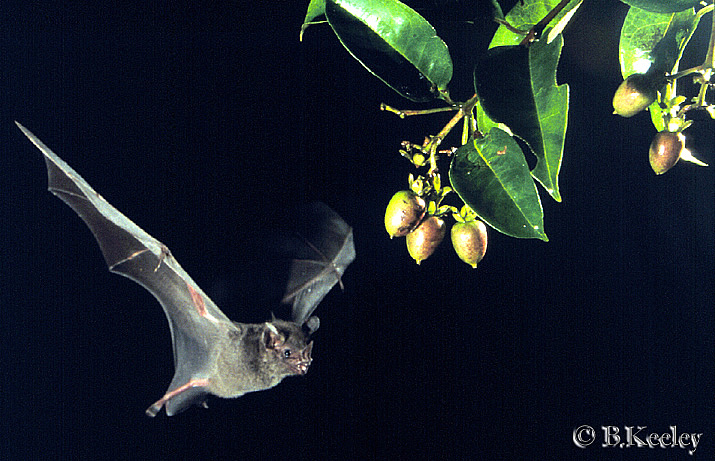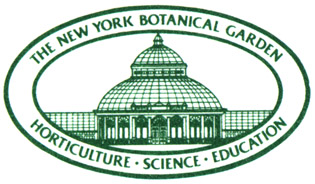Bat/Plant Interactions in the Neotropics
THIS WEBSITE IS NO LONGER MAINTAINED. THE DATABASE IS NOW AT WWW.BATPLANT.ORG
Tatyana A. Lobova
Introduction
The purpose of these web pages is to communicate the important role that bats play in the pollination and dispersal of plants in the Neotropics. We present data on bat/plant interactions in central French Guiana: Bats as Pollinators and Bats as Dispersers. A project currently in preparation is an Atlas of Seeds of Neotropical plant species dispersed by bats. We also present a searchable Database in which one can find out what plants have been reported to be pollinated or dispersed by bats and what bats are known to pollinate or disperse plants in this, the floristically richest region of the world. References from the Database are listed in the Literature.
We are especially grateful to the National Science Foundation, National Geographic Society, Beneficia Foundation, and Bat Conservation International for supporting our studies of bat/plant interactions, but, as can be seen in the following acknowledgments, many other people have helped us with our studies.
Additions and corrections to these bat/plant web pages should be reported to Tatyana Lobova (tlobova@odu.edu).
Our studies of the plants and plant/animal interactions, including the publication of the Guide to the Vascular Plants of Central French Guiana, would not have been possible without the collaboration of many botanists, zoologists, field guides, friends, and funding agencies.
The study of plants and their interactions of any geographic region are expensive undertakings. We thank the following funding agencies for financial support of many aspects of the project: National Science Foundation Grant No 0414098 (support of research and field work on bat/plant interaction), NSF-NATO Program Grant awarded in 2003 (support of research), National Geographic Society (support of field work), Bat Conservation International (support of research on bat/plant interactions), the Beneficia Foundation (general support), Bristol-Myers Squibb Foundation (computerization), the Harriet Ford Dickenson Foundation (general support), the Oliver S. and Jennie R. Donaldson Charitable Trust (botanical illustration), the Eppley Foundation for Research (salary support), Dorothy Salant and the G.A.G. Charitable Coorporation (general support), the Andrew W. Mellon Foundation (salary support), the Rockefeller Foundation (one field trip), Rhulen Family Foundation (botanical illustration), and the World Wildlife Fund - Guianas (publication). We are particularly appreciative of the support of the Beneficia Foundation, the Harriet Ford Dickenson Foundation, the Eppley Foundation for Research, and the Andrew W. Mellon Foundation for their general support of research at The New York Botanical Garden. Any opinions, findings, and conclusions or recommendations expressed in this material are those of the authors and do not necessarily reflect the views of the National Science Foundation.
We are especially grateful to Mr. John D. Mitchell for his long-term financial support. In addition to participation in many of these projects, John Mitchell has been the stimulus for many of the projects and for the interactions we have with other organizations such as Bat Conservation International.
Another source of funding has been through the Neotropical ecotour program of the Institute of Systematic Botany coordinated by Carol Gracie, and led by S. Mori, C. Gracie, and J. D. Mitchell. We are grateful to Sheila and Thane Asch, Robert Erler, John and Mary Feltmose, Susan Fredericks, Anne Hubbard, Katie Lee, Carol Levine, Anne MacNaughton, Sewell Moore, Alan and Mary Rolle, and Bob and Carol Russell for their additional support of our work.
Our numerous field trips to central French Guiana have been facilitated by many local people who have been recognized, for the most part, in the Acknowledgments of the Guide to the Vascular Plants of Central French Guiana. Nevertheless, we wish to recognize Françoise Crozier, Venise Isidore, and Lucien Aboukrat for their help with specimen management during our visits to the Herbier de Guyane; the successive directors of the Centre ORSTOM de Cayenne, who have allowed us and many of our collaborating specialists to use the collections of the Herbier de Guyane; and our special friends Bernard Hermier, Marie-Françoise Prévost, and Gerard Tavakilian who helped make our trips to French Guiana so pleasant. Our fellow French biologists, Pierre Charles-Dominique, Georges Cremers, Christian Feuillet, Jean-Jacques de Granville, Vanessa Hequet, Michel Hoff, Bernard Riera, and Daniel Sabatier have been instrumental in helping us accomplish all that we have done or will continue to do in French Guiana.
We are grateful for the collaboration of three skilled artists. We thank Bobbi Angell for most of the illustrations found in the Guide; Michael Rothman for his paintings of rain forest landscapes and sketches of expedition activities, and Katie Lee for her illustrations of bats visiting plants. We thank Carol Gracie (cgracie@nybg.org) for many of the plant photographs, Merlin Tuttle (mtuttle@batcom.org) and Brian Keeley (mormoops@cs.com) for the bat photos. These images are their property and should not be used without their permission.
Over the years, we have been fortunate to have the help of several New York Botanical Garden volunteers, but two, John L. Brown and Edmond Hecklau, have made outstanding contributions to our projects. We are thankful for their work and friendship. We are also grateful to Frédéric Blanchard, Kirsten Bohn, Brian Keeley, Alexander MacFarlane, Heather Peckham, Nancy Simmons, and Robert Voss for their collaboration on our bat/plant studies.
Scott Mori thanks his wife Carol Gracie for all that she has done to facilitate his studies of Neotropical plants. She has provided countless photos, endured field work on numerous expeditions, corrected poorly worded manuscripts, and displayed unusual patience with his demanding interest in tropical plants.
Go to TOP
Go to Bats
as Pollinators
Go to Bats
as Dispersers
Go to Seed Atlas
Go to Checklist
Go to Bat/Plant
Database
Go to Bat/Plant
Literature
Last updated: April 2007. For problems or questions, please contact: tlobova@odu.edu
